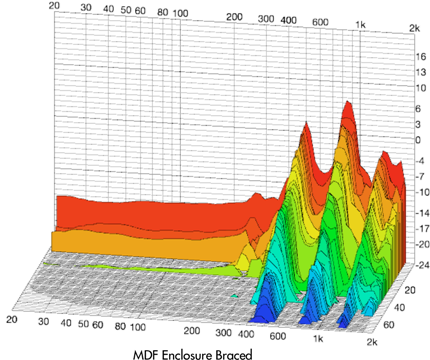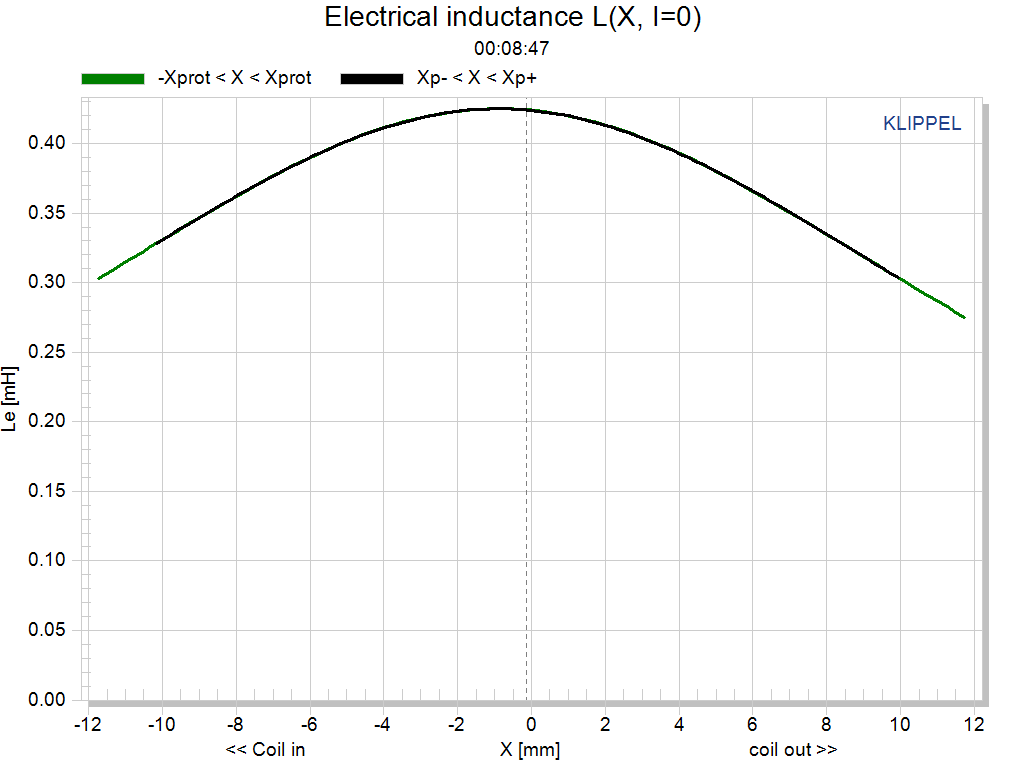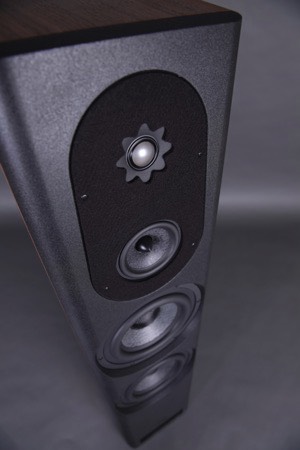Ryan S840
The drivers are blended seamlessly by the finely tuned crossovers producing near flat in room frequency response, even in less than ideal acoustic spaces. Each crossover component is chosen for its transparency and ability to let the music flow through unaffected.
The unique shape of the S-Series enclosures allows the acoustic centers of all drivers to be perfectly aligned. A large radius is applied to the front and rear baffles eliminating edge reflections. The S-Series features our silent core cabinet material with internal constrained layer damping. The S-Series enclosures reduce unwanted noise by up to 50dB compared to typical MDF enclosures.
We hope you can begin to see the care that has been taken to assemble what we believe are the finest speakers at their price points. In listening to the S-Series we hope you will hear all the amazing qualities of these loudspeakers and rediscover your music collection all over again.
S840 Design Highlights
The links below provide a brief explanation of the three areas of our speakers we feel are particularly important and have the biggest influence on what you hear.
ENCLOSURE DESIGN
As noise and distortion are greatly reduced and eliminated in other areas of the loudspeaker like the drivers and crossovers it becomes necessary to carry this thought process to the enclosure as well. The noise from a poorly engineered enclosure can easily be heard playing music at normal levels at the listening position.
As we began the development of the S series models we felt the enclosure was an area where we could make substantial improvements in performance.
Most loudspeaker enclosures use either MDF or some kind of plywood, MDF being by the most common material used in loudspeaker enclosures. The problem with MDF is that due to its stiffness it has a tendency to ring.
The waterfall plots below allow us to look in 3D at the noise produced by the enclosure. In the waterfall plot we can see frequency, amplitude and time. Ideally this curve would be completely blank.

The waterfall plot to the right shows an un-braced MDF enclosure. The measurement was taken on the side panel of the enclosure near the woofer driver.
Believe it or not there are many companies that make enclosures this way, these have no hope of actually producing neutral sound. This enclosure is more of a musical instrument than a speaker enclosure. The noise would be very audible at the listening position.
In enclosures constructed out of plywood the amplitude of the resonance is about the same as MDF but the frequency is shifted down approximately 200Hz giving the speaker an added warmth not in the original recording.

The waterfall plot to the right shows a typical very well braced MDF enclosure. The measurement was taken on the side panel of the enclosure near the woofer driver.
This enclosure has a vertical brace and two horizontal braces made out of MDF. The noise level produced by this enclosure is lower but still quite audible at the listening position.
This is where most companies stop in the development of their speaker enclosures.

S Series Silent Core Enclosure
The waterfall plot to the right is our new Silent Core laminated material with our internal constrained layer damping system. The measurement was taken on the side panel of the enclosure near the woofer driver.
The S series enclosure is constructed using our proprietary 9 layer material that breaks up unwanted vibrational energy. What little noise is left is eliminated by our internal constrained layer damping system.
The S Series enclosures have one of the lowest noise signatures of any product on the market. When you listen to an S series model this is reflected in the holographic soundstage and the amazing neutrality of the speaker.

The unique shape of the S series enclosures allow the acoustic centers of all drivers to be aligned to within a fraction of a millisecond. With the acoustic centers aligned the sound from all the drivers arrive at your years at the same time improving the coherence of the speaker.
The front baffle features a large radius minimizing edge reflections. Imaging precision is enhanced by the use of acoustical grade felt which covers the midrange and high frequency drivers mounted on the front baffle.
DRIVER DESIGN

FEA
Using finite element analysis modeling software we are able to design a magnetic system that moves the voice coil with identical force throughout its inward and outward movement. During the development of a new driver we analyze the amount of voice coil excursion that will be required under normal playback levels. To minimize power compression we simulate pole piece saturation as well as voice coil heating and ventilation. The overall goal being drivers that can reproduce any audio signal without altering it in any way.
Reproducing music accurately requires a loudspeaker driver to move in and out with perfect symmetry. As you can imagine if the amount of force required to move the driver in or out is different it will be absolutely impossible for the loudspeaker to reproduce music without adding distortion. Regretfully very few commercially available off the shelf drivers work this way.
The following three area of symmetry we consider to be critically important in the design of our drivers:

Magnetic (BL) Symmetry
The magnetic system of a driver is simply the motor that moves the cone or dome, the measurement of this is expressed as BL symmetry.
The Klippel Distortion Analyzer allows the measurement of BL field symmetry as show to the right. The black line represents the resting position of the woofer, the gray area above this is the voice coils outward movement and the gray area below the line is the inward voice coil movement. In analyzing our drivers we look for perfect symmetry of the gray area.

Suspension (KMS) Symmetry
The suspension of a woofer or midrange is composed of the surround and the spider. The suspension controls the movement generated by the voice coil. As with the voice coils movement we look for the mechanical resistance of the suspension to be symmetrical as the driver moves in and out. Our design goal is to match the voice coil and suspension maximum linear excursion so the driver handles the dynamic range of any type of music with complete control.

Inductance Symmetry
The voice coil of a driver has inductance somewhat like an inductor in a crossover. This inductance can cause the frequency response to change depending on the location of the voice coil. Our goal is to design drivers that have no measured change in frequency response from the voice coils rest position to the limit of its excursion. We do this by designing drivers with multiple shorting rings placed in strategic locations which minimize this inductance variation. What this means when you listen at low or high volumes the tonality of the speaker is not altered in any way.


The design goal for all of our drivers is to have as smooth as possible on and off axis frequency response. To achieve this smooth response in our drivers we employ amongst other things laminated cones. Laminating two dissimilar materials in our drivers, Nomex and Kevlar, we are able to eliminate the breakup of each material entirely. Nomex and Kevlar are both very light so the combined moving mass is similar to a typical Polypropylene cone.
In the graphs to the left you can see our 6.5" woofer and the 1" Beryllium tweeter used in the S series models. These measurements are performed in an anechoic chamber on a large test baffle allowing easily repeatable measurements in a completely calibrated environment. Both the woofer and tweeter curve are very flat with a very controlled roll off free of breakup.
CROSSOVER DESIGN

When a speaker is placed in a real room with walls, ceiling and floor the acoustical output from the speaker is reflected hundreds of times possibly before it finally reaches the listeners ears. Many speaker companies design their crossovers inside an anechoic chamber and once the speaker measures flat call the design finished. This completely ignores how the speaker will perform in a real room. In the design of all Ryan Speakers we use a combination of anechoic and in room measurements during the development and final voicing of our loudspeakers.
Crossover design generally follows the mathematical theories of people like Butterworth, Linkwitz-Riley, Bessel and Chebyshev. When you read speaker literature many times you will see these names quoted as well as the rate of roll off of the crossover which is generally anywhere from first order (6dB per octave) to fourth order (24dB per octave). The challenge when trying to implement any of these crossover theories on real speakers is that two critical assumptions are made: The drivers measure perfectly flat and the drivers all emanate sound from exactly the same point in space, both of the assumptions don’t occur very often in the real world. We solve this issue by using higher order, typically 12-18dB per octave asymmetric crossover slopes. Stated simply, we use crossover slopes that allow for the smoothest in room frequency response while minimizing distortion.
The quality of components used in a crossover have a clearly audible affect on the performance. Every component used in our crossovers has been evaluated for its transparency and absolutely minimal impact on the audio signal. The signal comes into the speaker through our proprietary oxygen free copper binding posts, after this the signal flows through low resistance perfect lay air core inductors, Mundorf metal oxide resistors and Clarity CSA polypropylene capacitors. Connecting the crossover to each driver is Cardas internal wiring soldered at every connection to ensure the high quality electrical connection.
S840 Reviews and Awards
S840 Specifications
Tweeter: 1” (25mm) Chambered Beryllium Dome Tweeter
Midrange 4" (100mm) Laminated Nomex Cone, Die cast frame
Woofer: Two 8” (205mm) Laminated Nomex Cone, Die cast frame
Crossover: 350Hz and 2200Hz
Frequency Range: 28Hz – 35kHz +/-3dB
Sensitivity: 88dB (2.83V@1m)
Impedance: 6 Ohms Nominal, 4 Ohms Minimum
Amplifier Power: 50-250 watts
Enclosure: Bass-reflex via front-firing port
Inputs: Bi Wire - 5 Way binding posts
Height: 45.52" (1156mm)
Width: 9.84" (250mm)
Depth: 20.55" (522mm) with grille
Weight Each: 100lbs (45.38kg) Shipping Weight
Finishes:
Oak Veneer with Clear or Black finishes
Walnut Veneer with Clear or Red finishes
Cherry Veneer with Clear finish
*specifications subject to change







